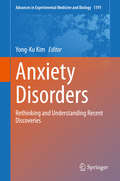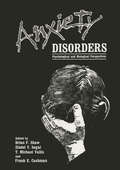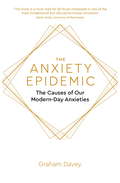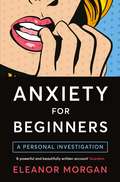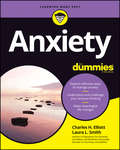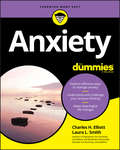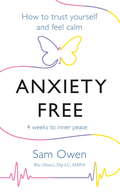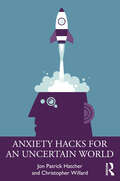- Table View
- List View
Anxiety Disorders: Pathophysiology and Pharmacological Treatment
by Gerard Emilien Cecile Durlach Ulla Lepola Timothy DinanIn this book, the discussion of the normal and pathological aspects of anxiety is critically examined. A chapter on the molecular basis of anxiety is included, outlining the potential of such approach in the discovery of novel effective pharmacological interventions. The face validity, predictability and usefulness of animal models in the design of valid new efficacious products are discussed. Separate chapters dedicated to each particular type of anxiety such as generalized anxiety disorder, social phobia, posttraumatic stress disorder, panic and obsessive-compulive disorder are included. This book should be of benefit to psychiatrists, clinical psychologists, general practitioners, nurses, students and all those engaged in neuropsychiatric research.
Anxiety Disorders (Primer On)
by Kerry J. Ressler, Daniel S. Pine and Barbara Olasov RothbaumAnxiety affects millions, manifesting as generalized anxiety disorder (GAD), obsessive compulsive disorder, panic disorder, phobias, post-traumatic-stress disorder (PTSD), and social anxiety disorder. Not only are anxiety disorders common, but they are also crippling, frequently co-occurring and predict high risk for depressive disorders. Shared mechanisms may explain the overlapping features of many anxiety disorders and account for associations with other highly-impairing conditions, such as major depression and substance use. Beyond risk for specific disorders, anxiety also predicts a number of other adverse outcomes, including suicidal behavior, medical problems, social, and economic difficulties. Conversely, disorder-specific mechanisms may also exist and explain the unique features of each syndrome. Thus, it is important to understand both shared and specific aspects of anxiety. The Primer on Anxiety Disorders provides early-stage practitioners and trainees, as well as seasoned clinicians and researchers, with need-to-know knowledge on diagnosis and treatment. Clinical cases are used throughout the book to enhance understanding of and illustrate specific disorders, comorbid conditions and clinical issues. To facilitate an integrative approach, content allows clinicians to understand patient characteristics and tailor interventions. The integrated approach of each chapter includes recent research on genetics and neuroscience to understand the mechanisms of anxiety disorders, focusing on the forthcoming new nosology in DSM-5. Chapters further integrate innovative advances in clinical research providing research on a range of discoveries regarding biomarkers of illness, biological predictors of treatments and the effect of treatment on neurocircuitry.
Anxiety Disorders: Rethinking and Understanding Recent Discoveries (Advances in Experimental Medicine and Biology #1191)
by Yong-Ku KimThis book reviews all important aspects of anxiety disorders with the aim of shedding new light on these disorders through combined understanding of traditional and novel paradigms. The book is divided into five sections, the first of which reinterprets anxiety from a network science perspective, examining the altered topological properties of brain networks in anxiety disorders. The second section discusses recent advances in understanding of the neurobiology of anxiety disorders, covering, for example, gene-environmental interactions and the roles of neurotransmitter systems and the oxytocin system. A wide range of diagnostic and clinical issues in anxiety disorders are then addressed, before turning attention to contemporary treatment approaches in the context of novel bio-psychosocial-behavioral models, including bio- and neurofeedback, cognitive behavioral therapy, neurostimulation, virtual reality exposure therapy, pharmacological interventions, psychodynamic therapy, and CAM options. The final section is devoted to precision psychiatry in anxiety disorders, an increasingly important area as we move toward personalized treatment.Anxiety Disorders will be of interest for all researchers and clinicians in the field.
Anxiety Disorders: Integrated Psychotherapy Approaches
by Judy Z. KoenigsbergThis text provides integrated and unified treatment frameworks for anxiety disorders and examines how contemporary integrated psychotherapy treatment models from different therapeutic interventions can be used to help patients. Dr. Koenigsberg provides a research-based overview of major themes that underlie these treatment models, then analyzes the symptoms and causes of specific anxiety disorders such as panic disorder, social anxiety disorder, and phobias, as well as obsessive-compulsive disorder, and posttraumatic stress disorder. Case studies of integrated or unified treatment approaches are provided for each disorder, along with the theoretical and technical factors that are involved in applying these approaches in clinical practice. Supplementary online materials include PowerPoint slides and test questions to help readers further expand their understanding of integrated and unified approaches for the anxiety disorders and assess their newfound knowledge. Graduate and undergraduate students, novice and seasoned therapists, and researchers will learn the rationale for and the history of past and contemporary integrated and unified models of treatment to gain better insight into anxiety disorders.
Anxiety Disorders: Integrated Psychotherapy Approaches
by Judy Z. KoenigsbergThis text provides integrated and unified treatment frameworks for anxiety disorders and examines how contemporary integrated psychotherapy treatment models from different therapeutic interventions can be used to help patients. Dr. Koenigsberg provides a research-based overview of major themes that underlie these treatment models, then analyzes the symptoms and causes of specific anxiety disorders such as panic disorder, social anxiety disorder, and phobias, as well as obsessive-compulsive disorder, and posttraumatic stress disorder. Case studies of integrated or unified treatment approaches are provided for each disorder, along with the theoretical and technical factors that are involved in applying these approaches in clinical practice. Supplementary online materials include PowerPoint slides and test questions to help readers further expand their understanding of integrated and unified approaches for the anxiety disorders and assess their newfound knowledge. Graduate and undergraduate students, novice and seasoned therapists, and researchers will learn the rationale for and the history of past and contemporary integrated and unified models of treatment to gain better insight into anxiety disorders.
Anxiety Disorders
by David J. Nutt James C. BallengerRapid developments in recent years in basic science and pharmacology has greatly increased understanding of the causes of anxiety disorders. This has led to a large number of new drug treatments from the pharmaceutical industry. This book makes sense of these advances and presents a coherent account of diagnosis and management from the clinical point of view. Chapters are in the form of surveys and digests of the recent literature and are interspersed with clinical guidelines, diagnostic and therapeutic points and are well illustrated.
Anxiety Disorders: Psychological and Biological Perspectives
by Brian F. ShawAnxiety is one of those entltles which everyone "knows", but which ultimately resists simple objective description. The essence of the phenomenon is its subjectivity. True it has its well documented associated physiological events: the increased pulse rate and blood pressure, sweating, and so on, but each of these phenomena may also be part of physical exertion, fear, or even pleasurable excitement. They cannot fully define the sense of threat, danger, collapse, malignancy in greater or smaller amount, in greater or lesser locali sation, with more or less objective evidence for its validity that characterises the particular psychological pain we all recognize as anxiety. It is precisely the essential subjectivity of anxiety and its association with an enormous range of experience that makes it difficult to assign to it well-defined diagnostic labels of the kinds so carefully described by Dr. Spitzer in his chapter on classification. His chapter ranges from the extreme dread of "Panic Disorders", to the diffuse terror of the environment which used to be labelled "Agoraphobia" (and is still so called in the day to day pragmatic usage of many clinics) and is not assimilated to the class of phobias with the label "Social Phobias". He also addresses the "Simple Phobias" which are perhaps the most readily labelled of the many varieties of anxiety.
Anxiety Disorders: A Guide for Integrating Psychopharmacology and Psychotherapy (Clinical Topics in Psychology and Psychiatry)
by Stephen M. Stahl Bret A. MooreDrs. Stephen M. Stahl and Bret A. Moore have created an instant classic in Anxiety Disorders: A Guide for Integrating Psychopharmacology and Psychotherapy. Anxiety Disorders is a comprehensive reference for the psychiatry and psychology student, intern, or resident, early career psychiatrist or psychologist, and the busy clinician. It distills the most important information regarding combined treatments for anxiety and presents the material in an easily accessible, understandable, and readable format. Each chapter addresses a specific type of disorder: PTSD, panic, generalized anxiety, obsessive-compulsive and other disorders, and is authored by prominent clinicians with years of experience in providing integrated, individualized treatments. With its thorough exploration of psychopharmacological treatments, psychosocial treatments, and, crucially, the integration of the two, Anxiety Disorders is a text no 21st-century clinician or student can afford to be without.
Anxiety Disorders: A Guide for Integrating Psychopharmacology and Psychotherapy (Clinical Topics in Psychology and Psychiatry)
by Stephen M. Stahl Bret A. MooreDrs. Stephen M. Stahl and Bret A. Moore have created an instant classic in Anxiety Disorders: A Guide for Integrating Psychopharmacology and Psychotherapy. Anxiety Disorders is a comprehensive reference for the psychiatry and psychology student, intern, or resident, early career psychiatrist or psychologist, and the busy clinician. It distills the most important information regarding combined treatments for anxiety and presents the material in an easily accessible, understandable, and readable format. Each chapter addresses a specific type of disorder: PTSD, panic, generalized anxiety, obsessive-compulsive and other disorders, and is authored by prominent clinicians with years of experience in providing integrated, individualized treatments. With its thorough exploration of psychopharmacological treatments, psychosocial treatments, and, crucially, the integration of the two, Anxiety Disorders is a text no 21st-century clinician or student can afford to be without.
Anxiety Disorders (Primer On)
Anxiety affects millions, manifesting as generalized anxiety disorder (GAD), obsessive compulsive disorder, panic disorder, phobias, post-traumatic-stress disorder (PTSD), and social anxiety disorder. Not only are anxiety disorders common, but they are also crippling, frequently co-occurring and predict high risk for depressive disorders. Shared mechanisms may explain the overlapping features of many anxiety disorders and account for associations with other highly-impairing conditions, such as major depression and substance use. Beyond risk for specific disorders, anxiety also predicts a number of other adverse outcomes, including suicidal behavior, medical problems, social, and economic difficulties. Conversely, disorder-specific mechanisms may also exist and explain the unique features of each syndrome. Thus, it is important to understand both shared and specific aspects of anxiety. The Primer on Anxiety Disorders provides early-stage practitioners and trainees, as well as seasoned clinicians and researchers, with need-to-know knowledge on diagnosis and treatment. Clinical cases are used throughout the book to enhance understanding of and illustrate specific disorders, comorbid conditions and clinical issues. To facilitate an integrative approach, content allows clinicians to understand patient characteristics and tailor interventions. The integrated approach of each chapter includes recent research on genetics and neuroscience to understand the mechanisms of anxiety disorders, focusing on the forthcoming new nosology in DSM-5. Chapters further integrate innovative advances in clinical research providing research on a range of discoveries regarding biomarkers of illness, biological predictors of treatments and the effect of treatment on neurocircuitry.
Anxiety Disorders and Gender
by Dan J. Stein Bavi VythilingumAnxiety and related disorders are common conditions that disproportionately affect women. In this book, the epidemiology, psychobiology, diagnosis, evaluation, pharmacotherapy and psychotherapy of major anxiety and related disorders are examined with special reference to the effects of gender and sex on clinical presentation and treatment. The conditions considered include generalized anxiety disorder, obsessive-compulsive disorder, panic disorder, posttraumatic stress disorder and social anxiety disorder. In addition, the management of anxiety and related disorders during pregnancy and lactation are discussed. Two concluding chapters specifically address anxiety disorders in women and in men, summarizing key points for clinicians and researchers. The authors are leading clinicians, including both psychiatrists and psychologists, from around the globe.
Anxiety Disorders and Related Conditions: Conceptualization and Treatment from Psychodynamic and Cognitive Behavioral Perspectives
by Christos Charis Georgia PanayiotouThe volume aims to instigate a dialog between the psychoanalytic and the cognitive-behavioral tradition on conceptualization and treatment of anxiety disorders and related conditions through contributions of respective experts. It presents current findings, and current theories and conceptualizations with regards to the mechanisms of etiology and maintenance of anxiety and related conditions, as well as innovative, new or experimental approaches to treatment that target core difficulties found in patients with anxiety. The book integrates basic research with conceptualization and treatment, while giving space for multiple perspectives to treatment, both psychotherapeutic and pharmacological, to be described. Chapters include a) conceptualization and treatment of anxiety and panic from psychodynamic perspectives, b) 2nd wave CBT treatment and the use of virtual reality, c) 3rd wave (ACT) perspectives, and d) neuroendocrine factors, and e) pharmacotherapy perspectives. Different theoretical approaches are presented highlighting the strengths and the evidence in favour of each approach, without promoting any specific perspective, but with an effort to highlight common underlying themes like safety behaviors and avoidance, social support, and role of learning history. In this way the book will present a combination of theory, science and practice aiming to be an excellent resource for researchers, clinicians and students of mental health professions.
Anxiety Disorders in Adults: An Evidence-Based Approach to Psychological Treatment (Guidebooks in Clinical Psychology)
by Peter D. McLean Sheila R. WoodyRecently developed psychosocial treatments for anxiety disorders reflect the systematic influence of scientifically generated knowledge, and these new treatments yield strong results. Research in such areas as information processing, cognition, behavioral avoidance, and the physiological components of anxious arousal has increased our knowledge of mediators that cause and maintain anxiety disorders. The development of these new clinical tools is timely, as epidemiological studies now show that up to 25% of people will experience at least one anxiety disorder in their lifetime. Meanwhile, mental health care providers are increasingly pressured to limit the number of sessions and use demonstrably effective treatments. In this book, the authors review psychosocial treatments for anxiety disorders, focusing on the scientific basis and demonstrated outcomes of the treatments. Cognitive behavioral therapies are highlighted, as they have been the most frequently investigated approaches to treating anxiety disorders. Individual chapters feature specific phobias: social phobia, panic disorder, and generalized anxiety disorder. The book is rich in clinical material and integrates science and clinical practice in an effort to help practitioners to improve the effectiveness of their work with anxious clients.
Anxiety Disorders in Adults A Clinical Guide
by Vladan Starcevic, MD, PhDUsing the practical yet comprehensive approach found in the first edition, the author considers each anxiety disorder's clinical complexity while simultaneously using an integrative orientation toward finding clinical solutions. The author considers the presentation of each disorder as it occurs and is treated in the "real world" of clinical practice. Finally, the volume addresses effective therapeutic procedures and recommendations, including pharmacological and psychological treatment approaches. A true "must read" for any psychiatrist interested in anxiety disorders.
The Anxiety Epidemic: The Causes of our Modern-Day Anxieties
by Graham DaveyAre we living in an age of unprecedented anxiety, or has this always been a problem throughout history?We only need look around us to see anxieties: in the family home, the workplace, on social media, and especially in the news. It's true that everyone feels anxious at some time in their lives, but we're told we're all feeling more anxious than we've ever been before - and for longer than we've ever done before. It's even reported that anxiety is a modern epidemic significant enough to challenge the dominance of depression as the most common mental health problem.Much of this increase has been attributed to changes in lifestyles that have led to more stress and pressure being placed on people: from childhood, to adolescence, to adulthood. But that's a big claim. Going back over the generations, how anxious were people in 1968 or 1818? Are people just anxious all the time - regardless of what they do or when they lived? Is anxiety an inevitable consequence of simply being alive?Graham Davey addresses many important questions about the role of anxiety. What is it good for? What are the unique modern-day causes of our anxieties and stresses? What turns normal everyday anxiety into the disabling disorders that many of us experience - distressing and debilitating conditions such as phobias, social anxiety, panic disorder, obsessive compulsive disorder, pathological worrying and post-traumatic stress disorder? To truly conquer anxiety, we need to understand why it has established its prominent place in our modern world.
Anxiety for Beginners: A Personal Investigation
by Eleanor MorganFoyles paperback of the year, Anxiety for Beginners offers a vivid insight into the often crippling impact of anxiety disorders, a condition that is frequently invisible, shrouded in shame and misunderstood. It serves as a guide for those who live with anxiety disorders and those who live with them by proxy.Combining her own experiences (rendered in emotive detail) with extensive research with experts (neuroscientists, psychiatrists, psychologists and fellow sufferers – including some familiar faces), Eleanor Morgan explores not just the roots of her own anxiety, but also investigates what might be contributing to so many of us suffering around the world.Anxiety for Beginners is, at its heart, a book about acceptance, as Morgan discovers the ways in which people can live a life that is not just manageable but enjoyable, learning to accept anxiety as part of who we are rather than spending a life fighting and being ashamed of it.
Anxiety For Dummies
by Charles H. Elliott Laura L. SmithExplore effective ways to manage anxiety Understand and challenge your anxious thinking Make meaningful life changes Manage anxiety—and start living your life! If you feel like your life is spinning out of control, you're definitely not alone! While anxiety is a natural reaction to stress, for some of us, it can become all-consuming—and ultimately debilitating. Thankfully, there is plenty you can do to combat anxiety with the help of this approachable guide. Inside, find out how adopting proven techniques like pinpointing triggers, improving health and eating habits, and learning to let go can help you effectively and deliberately manage your worries—and take back control of your life. Inside... Recognize symptoms Know useful vs. toxic anxiety Examine the causes of your anxiety Develop the practice of mindful acceptance Help your kids with their anxiety Block the blues Face your fears Adopt anxiety-reducing habits
Anxiety For Dummies: 2nd Edition (For Dummies Ser.)
by Charles H. Elliott Laura L. SmithExplore effective ways to manage anxiety Understand and challenge your anxious thinking Make meaningful life changes Manage anxiety—and start living your life! If you feel like your life is spinning out of control, you're definitely not alone! While anxiety is a natural reaction to stress, for some of us, it can become all-consuming—and ultimately debilitating. Thankfully, there is plenty you can do to combat anxiety with the help of this approachable guide. Inside, find out how adopting proven techniques like pinpointing triggers, improving health and eating habits, and learning to let go can help you effectively and deliberately manage your worries—and take back control of your life. Inside... Recognize symptoms Know useful vs. toxic anxiety Examine the causes of your anxiety Develop the practice of mindful acceptance Help your kids with their anxiety Block the blues Face your fears Adopt anxiety-reducing habits
Anxiety Free: How to Trust Yourself and Feel Calm
by Sam OwenA PRACTICAL GUIDE TO RESOLVING ANXIETYIn today's fast-paced, always-on world, many of us experience anxiety of some kind. But it doesn't matter whether it's crippling your everyday life or you find it rearing its head in specific situations, there are ways to work through it - and this book will equip you with the know-how to do just that.Using her tried and tested three-pillar system - identify the cause, identify the solutions, take thoughtful action - acclaimed life coach Sam Owen explains that anxiety is not your enemy, it's an indication that something in your life isn't right. By activating the three pillars and using the practical tools and step-by-step guide Sam presents you with, you can root out what's going wrong and thereby resolve your anxiety within just four weeks - enabling you to get back to the calm and positivity you so deserve.
Anxiety Hacks for an Uncertain World
by Jon Patrick Hatcher Christopher WillardAnxiety Hacks for an Uncertain World is a highly accessible guide to anxiety disorders. It helps anxiety sufferers regain control by suggesting an array of useful tactics which when applied can be life altering. Chapters explore key topics such as phobias, panic disorders, social anxiety, general anxiety, pandemics, and more. Additional resources are included in the appendix, such as support groups, services, and helplines. Using light humor and examples from their lived experiences the authors relate to readers and offer useful suggestions to overcome anxiety and understand it. This book will be essential for anyone suffering from anxiety and phobias or professionals working with this population. It can be used on its own or in conjunction with therapy.
Anxiety Hacks for an Uncertain World
by Jon Patrick Hatcher Christopher WillardAnxiety Hacks for an Uncertain World is a highly accessible guide to anxiety disorders. It helps anxiety sufferers regain control by suggesting an array of useful tactics which when applied can be life altering. Chapters explore key topics such as phobias, panic disorders, social anxiety, general anxiety, pandemics, and more. Additional resources are included in the appendix, such as support groups, services, and helplines. Using light humor and examples from their lived experiences the authors relate to readers and offer useful suggestions to overcome anxiety and understand it. This book will be essential for anyone suffering from anxiety and phobias or professionals working with this population. It can be used on its own or in conjunction with therapy.
Anxiety in Childhood and Adolescence: Encouraging Self-Help Through Relaxation Training (Routledge Library Editions: Anxiety #1)
by Frank Carter Peter CheesmanMany counter-productive behaviours in children may be anxiety-related and in this book, originally published in 1988, the authors proposed that a disabling level of tension and stress experienced by many children frequently goes unrecognised. This often leads to failure to analyse psychological and educational problems and inappropriate ways of dealing with them. This book was aimed at all professional staff working with children, particularly educational and clinical psychologists and teachers. The book is however written in a jargon-free manner and should have wide appeal. The authors show how tension reduction therapy can help children overcome many problems which may manifest themselves as disturbed behaviour, poor sleep patterns, anorexia, school phobia, or poor relationship-making skills. As an extreme example it is shown how significant gains can be made by cerebral palsied children using these approaches. The book, however, is not just a manual of relaxation training; it advocates a less stress-inducing approach generally to working with children, and gives many case studies.
Anxiety in Childhood and Adolescence: Encouraging Self-Help Through Relaxation Training (Routledge Library Editions: Anxiety #1)
by Frank Carter Peter CheesmanMany counter-productive behaviours in children may be anxiety-related and in this book, originally published in 1988, the authors proposed that a disabling level of tension and stress experienced by many children frequently goes unrecognised. This often leads to failure to analyse psychological and educational problems and inappropriate ways of dealing with them. This book was aimed at all professional staff working with children, particularly educational and clinical psychologists and teachers. The book is however written in a jargon-free manner and should have wide appeal. The authors show how tension reduction therapy can help children overcome many problems which may manifest themselves as disturbed behaviour, poor sleep patterns, anorexia, school phobia, or poor relationship-making skills. As an extreme example it is shown how significant gains can be made by cerebral palsied children using these approaches. The book, however, is not just a manual of relaxation training; it advocates a less stress-inducing approach generally to working with children, and gives many case studies.
Anxiety in Children (Routledge Library Editions: Anxiety #5)
by Ved P. VarmaThroughout the world – and particularly in developed countries – anxiety is one of the problems of modern living. It is not only adults who experience this problem, indeed, anxiety is often evident during periods of rapid change and since childhood is the period during which we develop most rapidly, then a strong case can be made for anxiety being especially prevalent in children. Originally published in 1984, Anxiety in Children gives a broad discussion, by well-known experts, of the issues of anxiety in children, focusing particularly on what those involved in mental health, paediatrics and educational and clinical psychology, can do to help. This book will still be of interest to all such professionals.
Anxiety in Children (Routledge Library Editions: Anxiety #5)
by Ved P. VarmaThroughout the world – and particularly in developed countries – anxiety is one of the problems of modern living. It is not only adults who experience this problem, indeed, anxiety is often evident during periods of rapid change and since childhood is the period during which we develop most rapidly, then a strong case can be made for anxiety being especially prevalent in children. Originally published in 1984, Anxiety in Children gives a broad discussion, by well-known experts, of the issues of anxiety in children, focusing particularly on what those involved in mental health, paediatrics and educational and clinical psychology, can do to help. This book will still be of interest to all such professionals.


